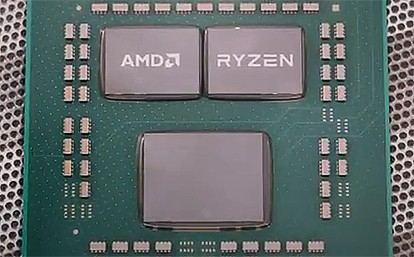AMD is going head-to-head with two of the largest semiconductor companies in the world, and perhaps the red team seeks to take the initiative against its blue and green rivals, because it is charging into battle with standard held high. Exactly as expected, AMD CEO Lisa Su announced a whole pile of new products during her opening keynote at Computex. Dr. Su specifically spoke about the third-generation Ryzen CPUs sporting the Zen 2 architecture and the Navi-based Radeon RX 5000-series graphics cards, but the Ryzen 3000-series CPUs are coming along with the new X570 chipset, too.
AMD CEO Lisa Su holds a Ryzen 9 3900X CPU on stage at Computex.
The good Doctor’s most exciting announcements were about the third-generation Ryzen desktop CPUs, also known as the Ryzen 3000 family. AMD says that the 7nm chips offer a 15% functional improvement in instructions-per-clock over Zen+. The chips also have enormous caches; AMD doubled the L3 cache from 8MB to 16MB per eight-core die. That distinction is important, because Lisa Su confirmed that AMD can and will stick multiple eight-core CPU dice on a single CPU package by announcing the Ryzen 9 3900X. This is obviously the first CPU in the Ryzen 9 family, and it comes with 12 cores and 24 threads clocked at up to 4.6 GHz. Here, just look at the table:
| 3rd-gen Ryzen desktop CPUs |
Cores / Threads |
TDP (Watts) |
Boost / Base clock |
L3 Cache |
SRP (USD) |
|---|---|---|---|---|---|
| Ryzen 9 3900X | 12 / 24 | 105 | 4.6 / 3.8 GHz | 32+32 MB | $499 |
| Ryzen 7 3800X | 8 / 16 | 105 | 4.5 / 3.9 GHz | 32 MB | $399 |
| Ryzen 7 3700X | 8 / 16 | 65 | 4.4 / 3.6 GHz | 32 MB | $329 |
| Ryzen 5 3600X | 6 / 12 | 95 | 4.4 / 3.8 GHz | 32 MB | $249 |
| Ryzen 5 3600 | 6 / 12 | 65 | 4.2 / 3.6 GHz | 32 MB | $199 |
AMD directly compared the Ryzen 7 3700X against the Core i7-9700K and in its own testing found that its chip beat the Intel offering by 1% in single-threaded workloads, and 30% in multi-threaded tasks—not that surprising given the latter chip’s lack of Hyper-Threading, but still impressive considering the Ryzen chip’s 26W TDP disadvantage. This writer was more impressed with AMD’s demo showing the Ryzen 7 3800X putting up a fight against the Core i9-9900K in PUBG. Also, the Ryzen 9 3900X edged out the Core i9-9920X in a Blender render in an on-stage demo. For those who don’t know, that Core i9 is an LGA 2066-socket chip with quad-channel memory.
There’s more to talk about here, including the massive L3 caches and the presence of PCIe 4.0, but the real newsworthy bits here are those prices. AMD will apparently be asking just $330 for an 8-core CPU that boosts up to 4.4 GHz, and only $500 for a 12-core CPU. AMD’s own Threadripper 2920X 12-core HEDT CPU goes for $629 on Newegg as I write this, and while that’s a larger and more complex processor than the Ryzen 9 3900X, it surely isn’t as fast—at anything. Also interesting is that these chips will slot into existing systems, even including some motherboards based around the first-generation X370 and B350 chipsets. Not all boards will work, though, so check your manufacturer’s site to make sure.
Speaking of motherboards, there’s that new X570 chipset, too. AMD says ASRock, Asus, Colorful, Gigabyte, and MSI are bringing out “over 50 new motherboard models” based on the X570 chipset, and there’s actually ample reason to upgrade. Unlike previous Socket AM4 chipsets, X570 is an in-house AMD design that offers up 16 lanes of PCIe 4.0 capability. That’s right—both the Ryzen 3000 CPUs and their chipset support PCI Express 4.0; a total of 40 lanes altogether if you count the 4 that will be used to connect the CPU to the chipset. There’s a bevy of boards to behold, and we’ll look at some of them in detail tomorrow when the whole staff isn’t on holiday.
Of course, aside from CPUs and system boards, AMD also announced new graphics parts. We fully expected AMD to trot out GCN one last time for us to gawp at, but instead, the company surprised us by announcing that Navi is based on what is purportedly a new graphics architecture called “Radeon DNA”, or RDNA for short. Dr. Su claimed on stage that RDNA offers the Navi graphics chips—which she officially christened as the Radeon RX 5000 series—a 25% boost in performance-per-clock and a 50% improvement in performance-per-watt over the company’s Vega architecture.
Given that AMD’s CEO explicitly referenced both design and process in her statement, that 50% improvement in performance-per-watt clearly includes the move to 7nm fabrication, so the comparison is against Vega 64, not the Radeon VII. The company performed a short on-stage demo of what Scott Herkelman, AMD RTG’s GM, referred to as a Radeon RX 5700, running Strange Brigade against a GeForce RTX 2070. The Navi-based Radeon pulled out around a 10% advantage in the canned benchmark, which is particularly decent given that the chip Lisa Su held in her hand was quite small indeed. That fits in neatly with earlier rumors that Navi would reside in the mid-range, at least at first.
We’re as thirsty as you are for more details about the next Radeons. AMD says cards bearing those chips will be available in July, and that the company will hold a livestream on June 10 from E3 with more details. The third-generation Ryzen chips, on the other hand, have a set release date: AMD says all five of the new CPUs, as well as new X570-based motherboards to mount them, should be stocked on store shelves on July 7.
